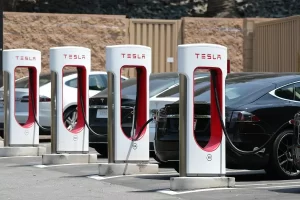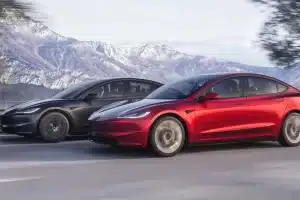The rise of Tesla is the most fascinating business story of the 21st century, and for me the most interesting part has always been the early days, when a motley crew of multitalented engineer/entrepreneurs hatched a bold strategy to challenge the most powerful of industries. I devoted a lot of space to Tesla’s early days in my history of the company, but now Mark Vaughn has gone even further back, and shared some previously unheard stories from Tesla’s prehistory in an article for Autoweek.
In 2003, Vaughn was testing cars at the California Speedway, and one day he got a call from Tom Gage, CEO of the pioneering EV firm AC Propulsion, asking if he could track-test a new car that he and his crew was working on. This turned out to be the tzero, which was named for t0, the mathematical symbol for a starting point in time. Little did anyone at the track that day realize that this bright yellow two-seat roadster would be the starting point of a far-reaching technological transition.
Or was it? Vaughn takes us even further back in time, to a little kit car made in Brighton, Michigan by an engineer named Dave Piontek. The Sportech, which was powered by a motorcycle engine, had a curb weight of 1,100 pounds and up to 250 hp, giving it “an absurd power-to-weight ratio of 4.4 pounds per hp.”
“It was a hell of a lot of fun,” Piontek, now retired and driving a motor home around Florida, told Vaughn. “I completed the original car in 1989. I painted it in my garage, I literally did probably 90% of the work myself. That car hauled ass!”
Piontek eventually built seven cars, one of which made its way to Dr. John Fagan, a professor of electrical engineering and computer science at the University of Oklahoma, around 1997.
Paul Carosa, who was AC Propulsion’s VP of Engineering, told me that Fagan was the one who originated the idea to build the tzero. “They did their own version of this little electric sports car that was based on a vehicle called the Piontek. [AC Propulsion founder] Alan Cocconi and I were intrigued by the idea, and we bought one of these vehicles from Piontek.”
Fagan put one of AC Propulsion’s electric drivetrains into his Piontek Sportech, and the result was no golf cart. “It was a badass drive,” Fagan told Mark Vaughn. “That thing had about three quarters the torque of a Tesla today.”
Fagan tried to get a manufacturer to build the car, but was unsuccessful. However, his efforts inspired the mad scientists at AC Propulsion to build their own electric-powered Sportech at their shop in San Dimas, California. This was the first tzero, and the rest is history.
However, history, at least in the automotive and tech worlds, progresses through a series of many iterations. The original tzero had 28 lead-acid batteries, which weighed 1,000 pounds and were mounted in the vehicle’s sides. It was a cramped, heavy car with a range of only 60 miles.
AC Propulsion’s second tzero prototype was powered by 6,800 laptop-style lithium-ion cells (cylindrical cells in the 18650 format). It was 700 pounds lighter than the original version, and had a range of about 300 miles. This was the car that Gage, Cocconi and company brought out to the California Speedway in 2003.
“It was lacking interior amenities, fit and finish, and a lot of other things that a mass-produced, modern day car would have,” Mark Vaughn recalls. “It likely wouldn’t have passed any crash-test standards anywhere in the world, either, but it launched quicker than almost anything made and was nimble and tossable and basically felt like a race car, or at least a very lightweight sports car. It needed sorting in the suspension department; it was too easy to get to oversteer, and even after we played around with camber and tire pressures, it still needed some sorting. But that’s what engineers do, and they eventually figured it out.”
Around this time, Martin Eberhard, a successful Silicon Valley entrepreneur who loved fast cars but was also concerned about the environment, had just gone through a divorce, and was looking to buy a sports car. He was already acquainted with Tom Gage, and he soon became intrigued by what was going on at AC Propulsion. Eberhard wanted to buy a tzero, but the AC Propulsion team had shifted their focus.
“We realized that we couldn’t continue to make money, let alone meet crash test standards and the like [with the tzero] so we sort of changed gears and started developing the eBox, an EV conversion based on the Toyota Scion xB” Tom Gage told me. They ended up building 25 units of the eBox, which was “a very practical utilitarian vehicle,” but Eberhard had his eye on bigger things, and he knew that practicality wasn’t the attribute that would get people to change their perception of EVs.
Now history really shifted into overdrive. Eberhard, joined by Marc Tarpenning, JB Straubel, Ian Wright and Elon Musk, used the tzero as the basis for the revolutionary Tesla Roadster. For the rest of the story, read Mark Vaughn’s Autoweek article (which includes some cool, never-before-seen photos), then read my book. It’s a fascinating tale, complete with conflicts, larger-than-life characters (not all of whom remember events the same way), near-death experiences, tragedy and triumph, and it’s far from over.
At the heart of the story, of course, is a series of ever-evolving automobiles, and Tesla’s Plaid Model S is the latest link in a lineage that goes all the way back to Dave Piontek’s garage in Brighton, Michigan.
Original Publication by Charles Morris at EVANNEX; Source: Autoweek





